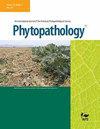求助PDF
{"title":"小侵略者,大麻烦:美国新出现的线虫威胁。","authors":"Camelia Kantor, Marcella Teixeira, Mihail Kantor, Cynthia Gleason","doi":"10.1094/PHYTO-09-24-0290-IA","DOIUrl":null,"url":null,"abstract":"<p><p>Plant-parasitic nematodes (PPNs) cause billions of dollars in agricultural losses annually. In the United States, a well-established list of prevalent nematodes serves as a foundation for addressing known threats. However, climate change is expected to trigger significant shifts in nematode populations, behaviors, and host ranges, introducing new risks to agricultural ecosystems. Understanding how nematodes adapt to evolving environments is crucial for predicting their spread to new locations and hosts. Beyond the spread of current PPN populations, there is the ongoing threat of undetected or nonnative PPNs entering the United States, potentially causing severe damage to agriculture and forest ecosystems. Continuous surveillance is vital to track nematode spread, and advancements, such as machine learning for nematode detection and quantification, enhance diagnostic capabilities. Additionally, remote sensing combined with geographic information systems is emerging as a powerful tool for pest management, offering spatial analysis and real-time monitoring. In this review, we highlight a selection of PPN species, including those with currently limited geographic distribution but posing a significant threat if introduced to new environments. We list these nematodes based on their host range, potential economic impact, and current molecular diagnostic methods. We propose the \"emergence triangle\" to explore how abiotic stresses impact nematode adaptation and how nematologists use innovative technologies to enhance surveillance efforts. Although ongoing diagnostic and monitoring efforts provide valuable insights, continuous surveillance is essential to track nematode spread. Critical questions remain regarding the criteria used by government officials to classify and regulate nematodes and who guides decisions on prioritizing threats. [Formula: see text] Copyright © 2025 The Author(s). This is an open access article distributed under the CC BY 4.0 International license.</p>","PeriodicalId":20410,"journal":{"name":"Phytopathology","volume":" ","pages":"587-595"},"PeriodicalIF":2.6000,"publicationDate":"2025-06-01","publicationTypes":"Journal Article","fieldsOfStudy":null,"isOpenAccess":false,"openAccessPdf":"","citationCount":"0","resultStr":"{\"title\":\"Tiny Invaders, Big Trouble: Emerging Nematode Threats in the United States.\",\"authors\":\"Camelia Kantor, Marcella Teixeira, Mihail Kantor, Cynthia Gleason\",\"doi\":\"10.1094/PHYTO-09-24-0290-IA\",\"DOIUrl\":null,\"url\":null,\"abstract\":\"<p><p>Plant-parasitic nematodes (PPNs) cause billions of dollars in agricultural losses annually. In the United States, a well-established list of prevalent nematodes serves as a foundation for addressing known threats. However, climate change is expected to trigger significant shifts in nematode populations, behaviors, and host ranges, introducing new risks to agricultural ecosystems. Understanding how nematodes adapt to evolving environments is crucial for predicting their spread to new locations and hosts. Beyond the spread of current PPN populations, there is the ongoing threat of undetected or nonnative PPNs entering the United States, potentially causing severe damage to agriculture and forest ecosystems. Continuous surveillance is vital to track nematode spread, and advancements, such as machine learning for nematode detection and quantification, enhance diagnostic capabilities. Additionally, remote sensing combined with geographic information systems is emerging as a powerful tool for pest management, offering spatial analysis and real-time monitoring. In this review, we highlight a selection of PPN species, including those with currently limited geographic distribution but posing a significant threat if introduced to new environments. We list these nematodes based on their host range, potential economic impact, and current molecular diagnostic methods. We propose the \\\"emergence triangle\\\" to explore how abiotic stresses impact nematode adaptation and how nematologists use innovative technologies to enhance surveillance efforts. Although ongoing diagnostic and monitoring efforts provide valuable insights, continuous surveillance is essential to track nematode spread. Critical questions remain regarding the criteria used by government officials to classify and regulate nematodes and who guides decisions on prioritizing threats. [Formula: see text] Copyright © 2025 The Author(s). This is an open access article distributed under the CC BY 4.0 International license.</p>\",\"PeriodicalId\":20410,\"journal\":{\"name\":\"Phytopathology\",\"volume\":\" \",\"pages\":\"587-595\"},\"PeriodicalIF\":2.6000,\"publicationDate\":\"2025-06-01\",\"publicationTypes\":\"Journal Article\",\"fieldsOfStudy\":null,\"isOpenAccess\":false,\"openAccessPdf\":\"\",\"citationCount\":\"0\",\"resultStr\":null,\"platform\":\"Semanticscholar\",\"paperid\":null,\"PeriodicalName\":\"Phytopathology\",\"FirstCategoryId\":\"97\",\"ListUrlMain\":\"https://doi.org/10.1094/PHYTO-09-24-0290-IA\",\"RegionNum\":2,\"RegionCategory\":\"农林科学\",\"ArticlePicture\":[],\"TitleCN\":null,\"AbstractTextCN\":null,\"PMCID\":null,\"EPubDate\":\"2025/6/6 0:00:00\",\"PubModel\":\"Epub\",\"JCR\":\"Q2\",\"JCRName\":\"PLANT SCIENCES\",\"Score\":null,\"Total\":0}","platform":"Semanticscholar","paperid":null,"PeriodicalName":"Phytopathology","FirstCategoryId":"97","ListUrlMain":"https://doi.org/10.1094/PHYTO-09-24-0290-IA","RegionNum":2,"RegionCategory":"农林科学","ArticlePicture":[],"TitleCN":null,"AbstractTextCN":null,"PMCID":null,"EPubDate":"2025/6/6 0:00:00","PubModel":"Epub","JCR":"Q2","JCRName":"PLANT SCIENCES","Score":null,"Total":0}
引用次数: 0
引用
批量引用

 求助内容:
求助内容: 应助结果提醒方式:
应助结果提醒方式:


